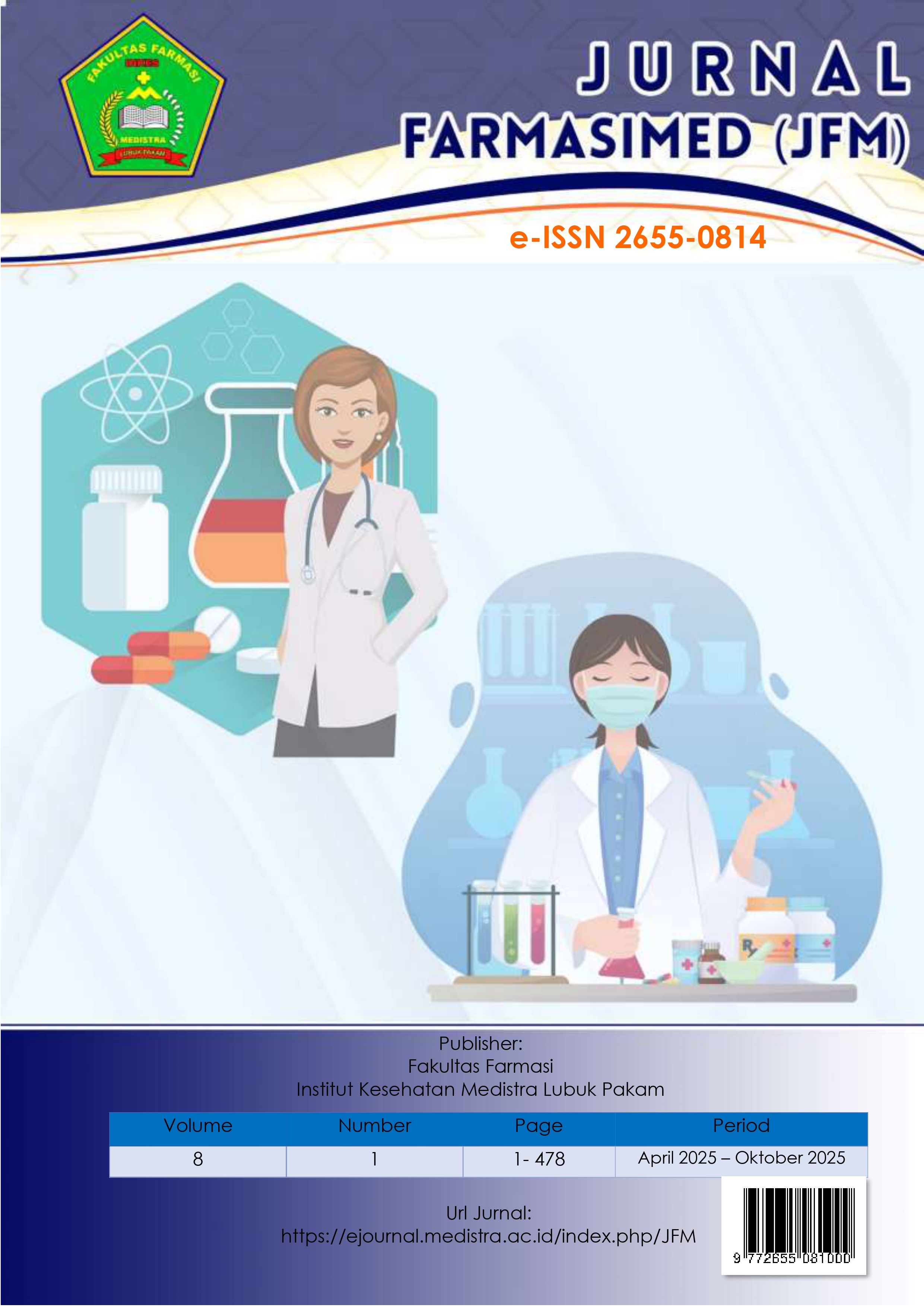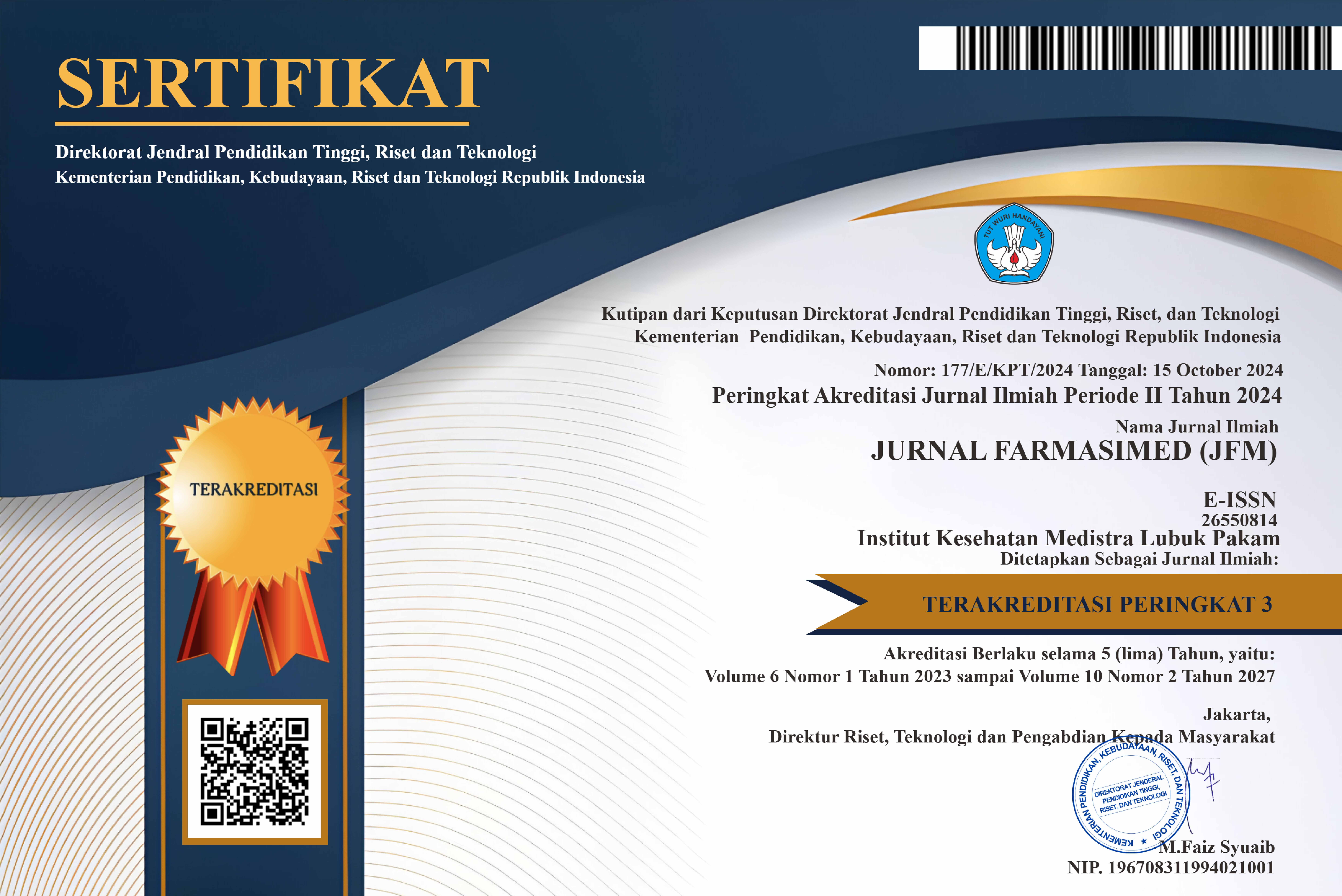Evaluation and Characterization of Caryophyllene Nanoemulsion Preparations from Clove Oil (Syzigium aromaticum)
DOI:
https://doi.org/10.35451/zz7g4329Keywords:
Kariofilen, Minyak Cengkeh, NanoemulsiAbstract
The clove plant (Syzygium aromaticum) is a plant from the Myrtaceae family. Clove plants can be found in various countries, including Indonesia. The contents of the clove plant have been studied to have beneficial pharmacological effects, one of which is the caryophyllene content in the clove plant which has antioxidant, antibacterial, etc. activities. This research aims to create a formula and evaluate the physical characteristics of a karyophyllene nanoemulsion preparation from clove oil. The method for making nanoemulsion preparations is made into three formulas with varying concentrations of karyophyllene compounds as active substances, namely F0 (0%), F1 (0.5%), and F2 (1%). Evaluation of the preparation includes organoleptic tests, pH tests, particle morphology tests, stability tests, and nanoemulsion globule size tests. The results showed that the nanoemulsion preparations of caryophyllene compounds F0, F1, and F2 had globule sizes of 82 ± 1.45 nm, 95 ± 2.67 nm, 89 ± 1.46 nm on day 1, while on day 28 the globule sizes were 99±2.87 nm, 116±2.56 nm, and 121±1.56 nm. The nanoemulsion preparation is clear white, semi-thick, and has a distinctive aroma. The morphology of the nanoemulsion globules is spherical and homogeneous. All three nanoemulsion formulations demonstrated good physical stability, as indicated by the absence of precipitation, phase separation, and turbidity, as well as pH values within the acceptable range for nanoemulsion systems, despite a slight increase in globule size observed over the 28-day storage period.
Downloads
References
[1] Ticoalu, P.K., et al. 2024. Formulasi dan Evaluasi Sediaan Roll on Aromaterapi Minyak Cengkeh (Syzigium aromaticum) Khas Sulawesi Utara, 5(3), pp. 9126-9137.
[2] Ariyanti, A., Masruriati, E., Azka, M., & Hidayah, A. A. 2020. Roll on Aromaterapy Formula Activity Test Essential Oil Syzygium aromaticum L. Indonesian Journal of Global Health Research, 2(3), 265–270. https://doi.org/10.37287/ijghr.v2i3.395
[3] Zheng, G.Q., Kenney, P.M. and Lam, L.K.T. 1992. Sesquiterpenes from clove (eugenia caryophyllata) as potential anticarcinogenic agents’, Journal of Natural Products, 55(7), pp. 999–1003.
[4] Yang, X. dan Deinzer, M. 1994. Hydrolysis and Rearrangement Reactions of Caryophyllene Oxide. Journal of Natural Products, 57:4, 514-517.
[5] Aishwaya. J., Harini. N., K.M. 2020. Clove Oil and Its Role In Oral Health - a Review. International Journal of Pharmaceutical Science and Health Care, 3(4), pp. 155–168.
[6] Rajora, A., Kohli, K., & Nagpal, K. (2024). Formulation of itraconazole-loaded clove oil-based nanoemulsion using pseudoternary phase diagram for improved thermodynamic stability. Indian Journal of Pure & Applied Physics (IJPAP), 62(3), 142–151.
[7] Ullah, R. H., Waseem, M., Ahmad, S., & Saeed, A. (2022). Formulation and evaluation of Syzygium aromaticum essential oil nanoemulsion: Effects on Tribolium castaneum, wheat growth, and molecular docking for pest control. Brazilian Journal of Science, 4(3), 233–245.
[8] Ghazwani, M., Hani, U., Alqarni, M. H., & Alam, A. (2023). Beta-caryophyllene-loaded nanostructured lipid carriers for topical management of skin disorders: Statistical optimization, in vitro and dermatokinetic evaluation. Gels, 9(7), 614. https://doi.org/10.3390/gels9070614
[9] Agustin, E., Insanu, M., & Mauludin, R. (2023). Improvement in Pharmacological Activity of Mahkota Dewa (Phaleria macrocarpa (Schef. Boerl)) Seed Extracts in Nanoemulsion Dosage Form: In Vitro and In Vivo Studies. Pharmaceutical nanotechnology, 12(1), 90–97. Advance online publication. https://doi.org/10.2174/2211738511666230602100045.
[10] Shahavi, M. H., Hosseini, M., Jahanshahi, M., Meyer, R. L., Darzi, G. M. (2019). Evaluation of Critical Parameters for Preparation of Stable Clove Nanoemulsion. Arabian Journal of Chemistry, Vol. 12, 3225-3230
[11] P. H. Ratnapuri et al. 2022. Formulasi dan evaluasi nanoemulsi dari ekstrak herba kelakai. In Prosiding Seminar Nasional Lingkungan Lahan Basah, vol. 7, no. 2, pp. 262–268.
[12] Hamid, K.M., Wais, M. And Sawant, G. 2021. a Review on Nanoemulsions: Formulation, Composition, and Applications. Asian Journal of Pharmaceutical and Clinical Research, 14(4), pp. 22–28.
[13] Ahmad, N., Ahmad, R., Alam, M. A., & Samim, M. (2019). Preparation of a novel curcumin nanoemulsion by low-energy emulsification: formulation, characterization and in vitro evaluation. RSC Advances, 9(1), 3132–3144. https://doi.org/10.1039/C8RA09186E
[14] Handa, M., Sharma, P., & Chauhan, N. (2020). Optimization of surfactant- and cosurfactant-aided nanoemulsions: Importance of Tween 80 and PEG 400 combinations. ACS Omega, 5(22), 12921–12931.
[15] Anwer, M. K., Jamil, S., Ibnouf, E. O., & Shakeel, F. (2014). Enhanced antibacterial effects of clove essential oil by nanoemulsion. Journal of Applied Pharmaceutical Science, 4(10), 4–9.
[16] Đoković, J. B., et al. (2022). The impact of the oil phase selection on physicochemical properties and long-term stability of nanoemulsions. Pharmaceutics, 14(11), 2437.
[17] Bezerra, I. C., de Araújo, A. P., et al. (2024). Synthesis and physicochemical stability of a copaiba balsam nanoemulsion: lessons for oil selection and low surfactant formulations. ACS Omega, 9(2), 1903–1915.
[18] Haro-González, J. N., López-Mena, E., & Ortega, A. (2023). Optimization of clove essential oil nanoemulsions: evaluation and applications. Processes, 11(8), 2287.
[19] Kiromah, N. Z. W., et al. (2023). Development and characterization of clove oil microemulsion. Pharmacia, 70(4), 941–947.
[20] Chhabra, J., Singh, H., & Bhatia, S. (2023). Potential of nanoemulsions for accelerated wound healing: A review. Pharmaceutics, 15(6), 1503.
[21] Agustin, E. and Pratiwi, A., 2023. The Utilization of Secang Wood (Caesalpinia sappan L.) Extract Nanoemulsion as Natural Pigment in Lip Cream Preparations. Journal of Drug Delivery & Therapeutics, 13(10). https://doi.org/10.22270/jddt.v13i10.6242.
Downloads
Published
Issue
Section
License
Copyright (c) 2025 Eriska Agustin; Whilly Martavinus

This work is licensed under a Creative Commons Attribution-NoDerivatives 4.0 International License.
Copyright in each article is the property of the Author.

























